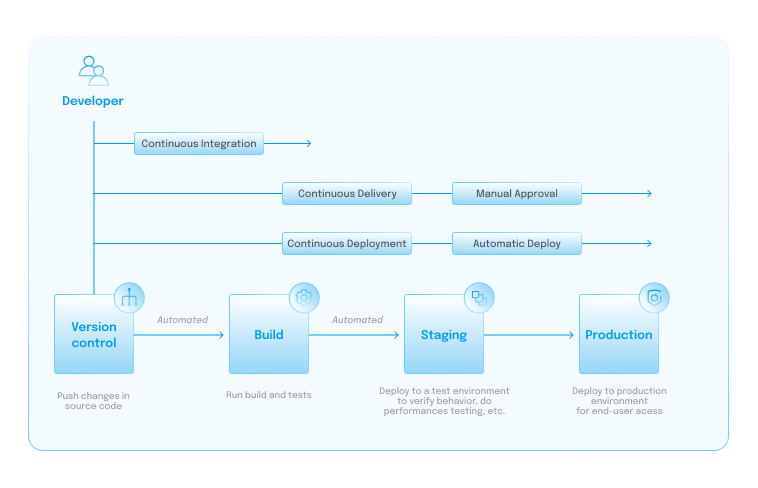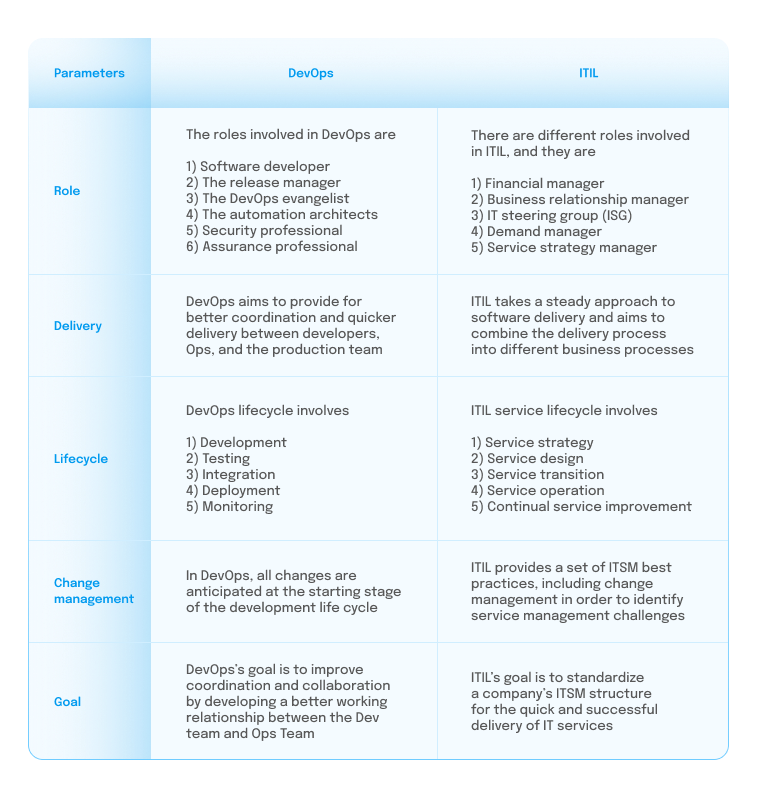Bridge the ITIL vs. DevOps mindset with CI/CD practices

DevOps practices in software development have revolutionized the way updates are released. However, many companies entrenched in ITIL practices find it challenging to seamlessly integrate with the DevOps practice of Continuous Integration and Continuous Delivery/Deployment (CI/CD).
This is because ITIL focuses on stability, which suits older systems, while DevOps is ideal for modern setups with its agile, automated practices. While challenges can arise from corporate politics and cultural differences between ITIL and DevOps, we can bridge these differences when implemented correctly.
In this comprehensive guide, we’ll explore the tech stack options for building a robust CI/CD pipeline and shed light on best practices on how ITIL-based companies are increasingly adopting CI/CD methodologies.
Read on to learn:
- What does CI/CD mean?
- What’s the difference between CI and CD?
- What does ITIL mean?
- Pros and cons of using CI/CD
- Pro and cons of using ITIL
- Reconciling ITIL with DevOps CI/CD practices
- Three ways to create a hybrid ITIL and CI/CD model
- Best practices for CI/CD alongside ServiceNow
- How BigPanda supports hybrid CI/CD and ITIL
- Building a successful hybrid ITIL and CI/CD model
What does CI/CD mean?
CI/CD are automated processes that help release software updates quickly and with low risk. This means that new features or fixes can be rolled out multiple times a day, or even every hour, without causing performance issues.
‘Establishing a CI/CD pipeline’ is a workflow best practice used by DevOps teams. These practices are widely used in the software industry and by companies looking to make their development processes more efficient, reliable, and flexible.
CI vs CD: What’s the difference?
CI, or Continuous Integration, involves regularly combining code changes from different developers into a central hub. This triggers a series of automated steps, like building, analyzing, and packaging the code, to ensure it meets quality standards.
CD stands for Continuous Delivery/Continuous Deployment. Continuous Delivery automates the process of getting code changes ready for release. It includes sending the code to a staging area for extra testing so that it can be deployed at any time. However, the final decision to release the code is made by a person, and not automated.
Continuous Deployment takes Continuous Delivery a step further. It automatically deploys code changes directly into production, smoothly updating the software for users without any interruptions or freezes.
In short, CI and CD work together in the software development process. CI focuses on frequently combining small code changes, ensuring that the code is always of high quality. This is where many teams start before moving on to more advanced practices like CD, which focuses on automating and readying the code for release.

What does ITIL mean?
ITIL stands for Information Technology Infrastructure Library. ITIL was established in the 1980s and provides best practices for IT services and software development. The configuration management database is a key component of ITIL. It acts like a central hub, managing services, users, software, hardware, documents, and IT elements for the central authority.
ITIL guidelines share best practices and tested processes for everything from incident management to problem management to change management. ITIL uses a change management process that carefully tracks and oversees changes from start to finish to minimize risk. Many companies using ITIL have been around for a long time and operate on traditional on-premise legacy systems or a mix of on-premise and cloud services.
Pros and Cons of CI/CD
- Fostering innovation and experimentation: CI/CD encourages a culture of continuous improvement and experimentation. Teams can easily test new features and innovations, enabling a more dynamic and innovative approach to software development.
- Rapid deployment and flexibility: CI/CD is great for quickly deploying code, which is crucial for staying competitive and responsive to the market. Automation helps reduce mistakes, speeds up development cycles, and ensures consistency. It creates a flexible environment, allowing quick responses to feedback and market changes, and fostering innovation.
- More monitoring opportunities: CI/CD lets you manage monitoring configurations through source control systems and utilize CI/CD to ensure all new apps are monitored before deployment. Automated tests in the pipeline will block any code deployments that lack monitor and alert rules. This encourages developers to set up proper monitoring best practices.
- Lack of risk management: Because of its speed-oriented nature, CI/CD may sometimes overlook assessing risks, leading to unexpected problems. Since CI/CD involves putting software through rapid changes, this increases the risk of incidents and potentially even customer-facing outages. The technology stack also undergoes more frequent changes, increasing fragmentation. In industries with strict rules, the fast pace might make it harder to comply with regulations.
Pros and Cons of ITIL
- Emphasis on controlled change and risk assessment: ITIL change management ensures that changes are thoroughly planned, assessed for risks, and executed in a controlled manner. This minimizes disruptions and potential negative impacts on existing systems and services.
- Enhanced stability and reliability: ITIL helps maintain a stable and reliable IT environment by carefully managing changes. This is especially critical for businesses where uptime and stability are essential, like in industries where downtime can lead to significant financial losses
- Secure and highly compliant: ITIL’s change management process precisely tracks and manages changes from start to finish to decrease risk. It follows a top-down, committee-driven approach, evaluating each change request’s impact on various aspects of the organization. This method emphasizes safety and risk reduction, which is crucial in industries like healthcare or finance with strict regulations.
- Slower deployments: Unlike the CI/CD and DevOps focus on constant software updates, older ITIL systems aren’t built for rapid, iterative changes. However, recent updates to ITIL incorporate more modern practices like automation, containers, and microservices.
- Higher potential overhead: The rigor and documentation required by ITIL change management tools can lead to additional administrative overhead. This may require dedicated resources and can be resource-intensive for smaller organizations.
Reconciling ITIL with DevOps CI/CD practices
The shift towards agile DevOps practices like CI/CD marks a notable departure from older software release methods that depended on manual integration and deployment. Companies following ITIL practices must align ITIL’s step-by-step release process with CI/CD’s fast, iterative methodology. This alignment is also needed with both teams’ corporate expectations and cultures.
Some see the ITIL vs DevOps mindsets as conflicting. However, they can work well together in companies when implemented thoughtfully. ITIL focuses on stability, which suits older systems, while DevOps is ideal for modern setups with its agile, automated practices.
Three ways to build a hybrid ITIL and DevOps CI/CD model
Organizations can blend ITIL change management and CI/CD to get the best of both worlds. This creates a hybrid approach that balances controlled changes with fast deployment in IT operations. To make these approaches work together, advocates must bridge organizational gaps to satisfy DevOps and operations teams.
Here are three ways that ITIL and CI/CD are commonly used together.
- ITIL for service management, CI/CD for software improvements
One way is to use ITIL for a service management foundation and add in CI/CD for ongoing software improvement. For example, CI/CD tools can make ITIL change management quicker and less risky - ITIL for standards, CI/CD for dynamic creativity
ITIL sets up rules and standards for how things are done inside and outside a company. On the other hand, the DevOps practice of CI/CD relies on your team’s skills and encourages thinking creatively. It guides in pushing the quick release of new updates to the customer. By implementing both methodologies, you gain the advantages of both and a beginning point to improve work and operations faster and better. - ITIL and CI/CD together for improved infrastructure and service management
Encouraging teamwork between development and operations teams also helps to bring ITIL and CI/CD together. This leads to better decisions about infrastructure and service management. This inclusive approach builds understanding and strengthens the coexistence of ITIL and DevOps. By combining the strengths of both ITIL change management and CI/CD, organizations can take a hybrid approach and balance careful changes and speedy deployment in their IT operations.
Best practices for CI/CD alongside ServiceNow
What’s the solution for companies happy with ServiceNow’s ITIL but frustrated with its CI/CD limitations? To run ITIL and CI/CD in parallel, they must convert a large volume of automation data into actionable insights.
To bridge this gap, companies need AIOps to gain visibility and intelligence into the entire change management process and associate that data with alerts and incidents during the ITIL incident response workflow.
BigPanda’s Operational Intelligence and Automation Platforms ingest and intelligently correlate multi-source events and alerts to reduce noise, duplicative, and low-value alerts. Then, the incidents are automatically enriched with CI/CD, CMDB, topology, and other data contextualization sources to identify actionable alerts with rich metadata.
How BigPanda supports hybrid CI/CD and ITIL
BigPanda acts as a bridge between CI/CD and ITIL in ServiceNow by automating ITIL processes that are complex, error-prone, and slow-moving. Automated notifications, ticketing, and workflow automation synchronize bi-directionally rich incident data in ServiceNow, so ITIL-based organizations can enjoy the benefits of CI/CD within their existing ticketing workflow.
BigPanda can also identify the root cause of incidents that are logged into ServiceNow. This is done by collecting change data directly from CI/CD pipelines and employing machine learning to correlate changes to incidents so developers can identify a change and roll them back to resolve an incident or outage.
Building a successful hybrid ITIL and CI/CD model
In conclusion, the integration of the CI/CD DevOps practices with ITIL-based organizations presents a unique challenge. While ITIL prioritizes stability and controlled change management, DevOps emphasizes agility and automation. Despite potential conflicts, it is possible to bridge these mindsets effectively.
Leveraging tools like BigPanda Operational Intelligence and Automation Platforms can help organizations streamline CI/CD and ITIL collaboration, convert automation data into actionable insights, and utilize AIOps. See it for yourself in our personalized demo to discover how you can gain visibility and intelligence into the change management process to facilitate smoother operations.
Ultimately, the successful integration of CI/CD with ITIL requires a thoughtful, balanced approach that combines the strengths of both methodologies. This hybrid approach enables organizations to balance controlled changes and rapid deployment to drive innovation and success in today’s dynamic IT landscape.
ITIL vs DevOps Cheat Sheet

Chart Courtesy of Veritis – ITIL vs DevOps



